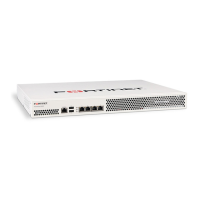Fortinet Technologies Inc. Page 19 FortiVoice 200D/200D-T v2.0 MR1 CLI Reference
Command abbreviation
In most cases, you can abbreviate words in the command line to their smallest number of
non-ambiguous characters. For example, the command get system status could be
abbreviated to g sy st.
Some commands may not be abbreviated. See the notes in the specific commands.
Special characters
The characters <, >, (,), #, ', and “ are not permitted in most CLI fields. These characters are
special characters, sometimes also called reserved characters.
You may be able to enter a special character as part of a string’s value by using a special
command, enclosing it in quotes, or preceding it with an escape sequence — in this case, a
backslash ( \ ) character.
Move the cursor to the beginning of the command line. Ctrl + A
Move the cursor to the end of the command line. Ctrl + E
Move the cursor backwards one word. Ctrl + B
Move the cursor forwards one word. Ctrl + F
Delete the current character. Ctrl + D
Abort current interactive commands, such as when entering
multiple lines.
Ctrl + C
Table 4: Shortcuts and key commands
Table 5: Entering special characters
Character Keys
? Ctrl + V then ?
Tab Ctrl + V then Tab
Space
(to be
interpreted as
part of a string
value, not to
end the string)
Enclose the string in quotation marks: "Security
Administrator".
Enclose the string in single quotes: 'Security
Administrator'.
Precede the space with a backslash: Security\
Administrator.
'
(to be
interpreted as
part of a string
value, not to
end the string)
\'

